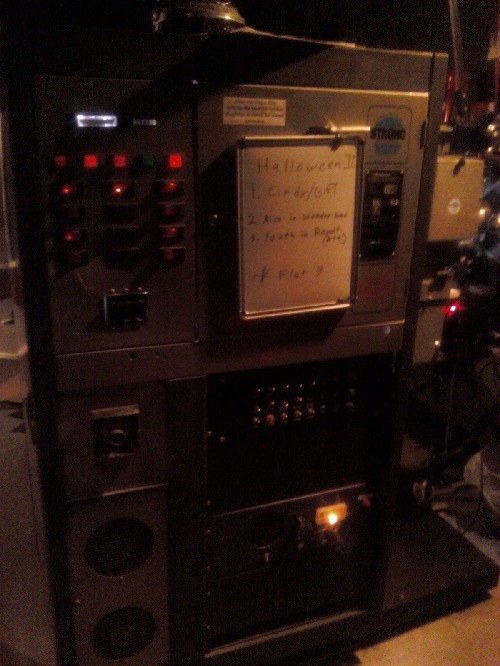|
|
This topic comprises 2 pages: 1 2
|
|
Author
|
Topic: Film guard usage
|
|
|
|
|
|
|
|
|
|
|
|
|
|
|
|
|
Randy Stankey
Film God

Posts: 6539
From: Erie, Pennsylvania
Registered: Jun 99
|
 posted 01-09-2010 09:24 PM
posted 01-09-2010 09:24 PM




Is a turd still a turd if you squash it into a ball? I say that if you form a turd into a ball it is no longer a turd. It would then be a shitball but not a turd.
Yes, you can polish a shitball but you still can not polish a turd because once you form a turd into a shitball it forever loses its turdness.
Repairing prints is best left up to the labs. With the equipment you have at the theater level, your options are rather limited.
You can clean a print with various and sundry chemical preparations.
You can splice a print back into some semblance of original order.
You can patch broken sprocket holes with various methods.
But, once a print is damaged, there is usually no way to restore it to original condition at the theater level.
You should even consider fingerprints to be permanent damage!
Yes, the oil and dirt from your fingerprints can actually absorb into the emulsion, leaving a virtually permanent mark. There are some chemicals that can be used to remove fingerprints but they are usually pretty nasty.
If you send a print back to the lab it can be run through a special machine to "rewash" it and remove much of the dirt and even heal some scratches. But, once film is cut, it can never be "uncut." It can only be respliced.
Once film is scratched, it can never be "unscratched." You can only hide the damage.
If film is scratched down to the emulsion, that's all she wrote!
Scratching away the emulsion removes part of the image on the film. There is no way to restore it.
The simplest way to "repair" film is to never damage it in the first place.
| IP: Logged
|
|
Brad Miller
Administrator

Posts: 17775
From: Plano, TX (36.2 miles NW of Rockwall)
Registered: May 99
|
 posted 01-09-2010 09:46 PM
posted 01-09-2010 09:46 PM




Michael,
I'll need some answers from your specifics to give the best advice.
1. Is this print plattered or running reel to reel?
2. If reel to reel, is it 20 minute reels or 60 minute reels?
3. If platter, does this print get moved off of the platter each week?
4. If platter, what brand of platter are you working with?
5. Do you have a Christie or Kelmar "media" cleaning machine like is pictured here?
To get the optimum results, I will need to know the answers to those questions. More may be forthcoming depending on the answers.
By the way, assuming you run that print once a week for 5 years, that is only about 250 passes. That is nothing. I've ran prints over 1500 passes before with NO hint of any deterioration, scratches or dirt buildup of any sort. The trick, as the guys above are trying to tell you, is that corrective actions are never as effective as preventive actions.
| IP: Logged
|
|
|
|
Brad Miller
Administrator

Posts: 17775
From: Plano, TX (36.2 miles NW of Rockwall)
Registered: May 99
|
 posted 01-09-2010 11:08 PM
posted 01-09-2010 11:08 PM




You've got everything working against you here.
You have a platter that does not wind tight. You have a print that was permitted to get dirty. This means every week when you move it for storage, you are putting more and more scratches in it (little "scuff marks" and such...the lines were a threading error). Because the Strong platters don't wind tight, the film is permitted to slip on itself during this move. To top it off, your projector puts more wear on a print than a Century, Christie, Cinemeccanica, Kinoton, etc due to the soundhead design.
But wait there's more.
When you go to clean this print, that craptacular platter has no backtension of any sort, so any cleaning attempts on your part will take twice as many passes to do the same job as if you were running a Christie platter.
That being said, this is what I would do given the circumstances.
First off, use Film-Tech or Kelmar brand media ONLY. If it doesn't have the little embossed "brick" pattern on the surface, don't use it! You will create MORE scratches if you use that type of media on a dirty print because the dirt has nowhere to go. (The dirt on Film-Tech and Kelmar media can drop in the "grooves" of the media to protect the print from getting scratched.)
Next, makeup your film cleaner at least 24 hours before, by soaking the media down and letting it sit out. 48 hours before would be preferred. The reason is because when you are dealing with an old print like this being fed via a Strong platter, you do not want to over-saturate the print. You want the media barely damp for this purpose.
The first pass will do nothing for cleaning. It never does. The first pass is all about lubricating the print to protect it. The actual "cleaning" process starts with the second pass. Save the media pads after this first pass. Store the entire cleaner (or if you have to strip the media rolls off of it) in a ziploc baggie. They make large ones big enough for the entire cleaner.
The second week will be your second pass. Re-use the same stretch of media and make sure you put the same roll on the top spindle of the film cleaner that you did the week before. Don't mix and match the emulsion vs. the base side cleaning pads. You will NOT be adding any FilmGuard before this second show.
Starting with the third week you will be on a monthly change-out:
Week 1 - New media pads, saturated down 48 hours ahead of time (at least 24 hours before the show).
Week 2 - Same pads rewound so you are using the same stretch of media. Do not resaturate the pads.
Week 3 - Same pads rewound so you are using the same stretch of media. Do not resaturate the pads.
Week 4 - Same pads rewound so you are using the same stretch of media. Do not resaturate the pads.
Repeat steps 1-4 for weeks 5-8 and so forth.
I believe RHPS takes either 5 foot or 5.5 foot length rolls of media. If you are ONLY using FilmGuard on your RHPS print, one box of media and one bottle of FilmGuard will last you a couple of years. Hand-wind 5.5 feet of media onto an empty core and run those. If you run the full 16 feet of media on the rolls as they come from the manufacturer, the other 10 feet will absorb FilmGuard unnecessarily, emptying your bottle faster.
Remember, load the pads DRY onto the cleaner. Wind the takeup core a full 3 turns past bare minimum. THEN push the sprayer nozzle up against the dry pads to saturate them. If you wet the pads before loading them onto the cleaner, you run the risk of the tape loosening on the takeup shafts and if you hit some sprocket damage or a bad splice (both applicable on most RHPS prints), you could actually end up pulling the media free and causing it to unravel during the show. If you load them up DRY before wetting them down, that won't happen.
Also, see if you can go buy yourself two thick (half inch) pieces of masonite and have it cut into a circle 3.5 feet in diameter. (Make sure it is a smooth cut, not one hand-done with a jigsaw.) Then have the center cut out enough to clear the brain of the platter (I'm guessing 10-12 inches) and then drill out a couple of holes with a 1/2 inch drill for your two center ring pegs. This way you will be creating yourself a sturdy and only mildly bendable "donut" to run the print onto and off of during the show. This will help prevent more scratches in the future as you keep physically picking up and moving that dirty print, because you will be picking up and moving the "donuts" with the film sitting on top. Remember, that dirt is abrasive against the next layer of film!
| IP: Logged
|
|
|
|
|
|
|
|
|
|
All times are Central (GMT -6:00)
|
This topic comprises 2 pages: 1 2
|
Powered by Infopop Corporation
UBB.classicTM
6.3.1.2
The Film-Tech Forums are designed for various members related to the cinema industry to express their opinions, viewpoints and testimonials on various products, services and events based upon speculation, personal knowledge and factual information through use, therefore all views represented here allow no liability upon the publishers of this web site and the owners of said views assume no liability for any ill will resulting from these postings. The posts made here are for educational as well as entertainment purposes and as such anyone viewing this portion of the website must accept these views as statements of the author of that opinion
and agrees to release the authors from any and all liability.
|

 Home
Home
 Products
Products
 Store
Store
 Forum
Forum
 Warehouse
Warehouse
 Contact Us
Contact Us




 Printer-friendly view of this topic
Printer-friendly view of this topic








![[Wink]](wink.gif)

![[Big Grin]](biggrin.gif)






